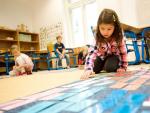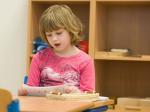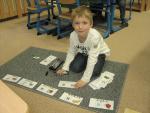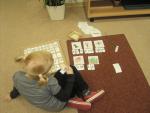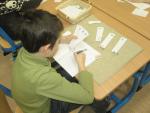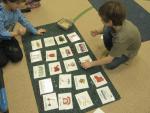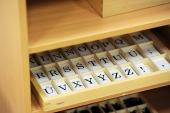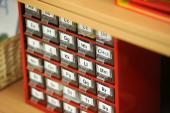Language education
The language material is also used in the areas of practical life and sensory education. The Czech language becomes a separate area of interest of kindergarten children. Children get acquainted with individual letters through all their senses. They learn to write and to read simple words. They express their views in the chosen topics on an elipse, and thus they develop their vocabulary.
In the primary school we continue fixing early writing and reading through visual materials and texts chosen according to the genetic method of reading. These materials are also connected with the topics discussed in the cosmic education. For example, children learn some types of phrases in a „story about a hedgehog“ and, while learning about the grammar, they also learn some interesting facts about hedgehogs. Pupils proceed step by step from a concrete aid (eg. children outline emery letters while calling them out) up to abstract things, worksheets (eg. from emery letters to writing in exercise books).
After practising early writing and reading, children start learning various grammatical rules, as they do in a classical primary school. The curriculum of learning letters is the same for individual years but the only difference lies in how children do it. First, children get familiar with factual materials of the curriculum, so that they can deduce new rules themselves and learn them. We try not to deprive our pupils from those situations in which they can say “I see“ – that means they find out the rule on their own without a ready made explanation of their teacher.
Only later on they start working with worksheets and other materials in order to fix and practise a new orthographic rule (the volume always depends on the needs of an individual child). Children plan, organize and evaluate their work themselves. This way they learn the most important life skills. They work with the aids on their own, individually, but mainly, with their own speed.
Pupils do not learn spelling only through rules, they often read and write. They practise writing through creative writing. First of all, they need to find out that they do like writing and that it is good to use correct orthography if they want their writing to be nice and understandable. Children use their writing to communicate their thoughts, to explain what they’ve found out about a given topic, to record interesting experiences. They present their individual or group written work to each other and they learn how to assess work of others and how to hand over the information which they gained through their diligence.
In order to ensure that a child gets pleasure from reading, he has to be given the opportunity to speak about his reading and share his reading experiences with others. At school children do not read extracts from reading books without any context - they work with books, encyclopedia and dictionaries in the library. The compulsory literature is presented in a wider context of particular topic units (eg.when talking about various literary genres).


